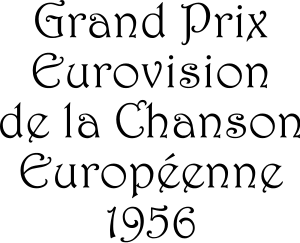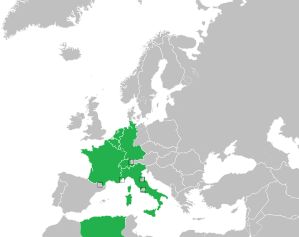Eurovision Song Contest 1956
| Eurovision Song Contest 1956 | ||||
|---|---|---|---|---|
 | ||||
| Dates | ||||
| Final | 24 May 1956 | |||
| Host | ||||
| Venue | Teatro Kursaal Lugano, Switzerland | |||
| Presenter(s) | Lohengrin Filipello | |||
| Conductor | Fernando Paggi | |||
| Director | Franco Marazzi | |||
| Executive supervisor | Rolf Liebermann | |||
| Host broadcaster | Radiotelevisione svizzera di lingua italiana (RTSI) | |||
| Interval act | Les Joyeux Rossignols & Les Trois Ménestrels | |||
| Participants | ||||
| Number of entries | 14 (7 countries performed 2 songs each) | |||
| Debuting countries |
| |||
| Participation map
| ||||
| Vote | ||||
| Voting system | Each country had 2 jury member who each had two votes, only the winner was announced. | |||
| Winning song | "Refrain" | |||
| Eurovision Song Contest | ||||
| ||||
The Eurovision Song Contest 1956 was the debut edition of the Eurovision Song Contest, held at the Teatro Kursaal in Lugano, Switzerland on Thursday 24 May. Organised by the European Broadcasting Union, the pan-European music competition was an inspiration of the Italian Sanremo Music Festival. Lohengrin Filipello hosted the first contest which lasted approximately 1 hour and 40 minutes. Seven countries participated, with each of them performing two songs. Two jury members from all participating countries cast their votes in secret, based on which song was their favourite.
This first edition of the Eurovision Song Contest included several procedures that were not repeated in any subsequent edition: Two songs for each country, secret voting, double voting of one country on behalf of another, optional inclusion of the jury members' own represented country in their voting, only "Grand Prix" title reception for the winner, and a single male presenter to host the show. The other Contests include: One song for each country, scoreboard display, jury panel from each country, disqualification of the juries' own country from their voting, material award, and a single or additional female presenter.
History
During a meeting in Monaco in 1955, members of the European Broadcasting Union discussed ideas to organise a pan-European music competition, taking inspiration from the Italian Sanremo Music Festival. From that meeting, the concept of the Eurovision Song Contest was born. A decision was reached to hold the first ever contest in the Swiss resort of Lugano the following year.[1]
Location
The chosen venue for the contest was the Teatro Kursaal in Lugano, a city in the south of Switzerland, in the Italian-speaking canton of Ticino, which borders Italy. The event was also inspired by the Italian music festival, as well as that the contest was hosted in Italian.
Format
The first programme was hosted by Lohengrin Filipello and lasted approximately 1 hour and 40 minutes. Although it was mainly a radio programme, there were cameras in the studio for the benefit of the few Europeans who possessed a television.[1]
Only solo artists were allowed to enter the contest, and their songs were not to exceed three and a half minutes in length, and were accompanied by a 24-musician orchestra, which was led by Fernando Paggi. The interval act, whistling by the Joyeux Rossignols, had to be extended due to a delay in the voting procedure. It had been strongly recommended that each participating country have a preliminary national song contest.[1]
Voting controversy
Two jury members from all participating countries travelled to Lugano to cast their vote on the songs in secret, although the jury members from Luxembourg were unable to make it to Lugano. The voting system at this Contest allowed juries to vote for any competing song, including those of their own country. Additionally, the Swiss jury was allowed by the EBU to vote also on behalf of the Luxembourg delegation. Some even think that the Swiss entry won because of this rule.[2] This system was never repeated.[1]
Lost tapes
While the contest was shown and recorded for television broadcasting in certain European countries (as television sets were somewhat uncommon still at this time), no copies have survived, with the exception of Lys Assia's repeat performance at the end of the contest. It is one of only two contests to not have survived completely, along with the 1964 contest (of which the tapes were destroyed in a fire).
Participating countries
Seven countries participated in the first ever contest, each were represented with two songs. Three more countries, Austria, Denmark, and United Kingdom were also expected to take part in the contest, but they missed the submission deadline and therefore could not take part. The BBC's Festival of British Popular Song, which had been intended to choose the United Kingdom entry, was in the end not held until after the Eurovision contest.[1]
Conductors
Each performance had a maestro who conducted the orchestra.[3] The conductors listed conducted both performances for the indicated countries.
-
 Netherlands - Fernando Paggi
Netherlands - Fernando Paggi -
 Switzerland - Fernando Paggi
Switzerland - Fernando Paggi -
.svg.png) Belgium - Léo Souris
Belgium - Léo Souris -
 Germany - Fernando Paggi
Germany - Fernando Paggi -
 France - Franck Pourcel
France - Franck Pourcel -
 Luxembourg - Jacques Lassry
Luxembourg - Jacques Lassry -
 Italy - Gian Stellari
Italy - Gian Stellari
Results
Except for the winning song, the results have never been published. Simon Barclay's book The Complete and Independent Guide to the Eurovision Song Contest 2010 includes a table with what appears to be the results, but the author does not give a source and under the chart he writes that "the votes awarded have never been disclosed."[4] According to writer Jan Feddersen, "Im Wartesaal zum großen Glück" was probably voted No. 2 behind Lys Assia.[5]
| Draw | Country | Artist | Song | Language[6] | Place[7] |
|---|---|---|---|---|---|
| 01 | |
Jetty Paerl | "De vogels van Holland" | Dutch | 2 |
| 02 | |
Lys Assia | "Das alte Karussell" | German | 2 |
| 03 | |
Fud Leclerc | "Messieurs les noyés de la Seine" | French | 2 |
| 04 | |
Walter Andreas Schwarz | "Im Wartesaal zum großen Glück" | German | 2 |
| 05 | |
Mathé Altéry | "Le temps perdu" | French | 2 |
| 06 | |
Michèle Arnaud | "Ne crois pas" | French | 2 |
| 07 | |
Franca Raimondi | "Aprite le finestre" | Italian | 2 |
| 08 | |
Corry Brokken | "Voorgoed voorbij" | Dutch | 2 |
| 09 | |
Lys Assia | "Refrain" | French | 1 |
| 10 | |
Mony Marc | "Le plus beau jour de ma vie" | French | 2 |
| 11 | |
Freddy Quinn | "So geht das jede Nacht" | German | 2 |
| 12 | |
Dany Dauberson | "Il est là" | French | 2 |
| 13 | |
Michèle Arnaud | "Les amants de minuit" | French | 2 |
| 14 | |
Tonina Torrielli | "Amami se vuoi" | Italian | 2 |
International broadcasts
The participating national broadcasters sent commentators to the contest, in order to provide coverage of the contest in their own native language. Details of the commentators and the broadcasting station that they represented are shown in the table below.[8]
-
 Netherlands - Piet te Nuyl[9] (NTS)
Netherlands - Piet te Nuyl[9] (NTS) -
 Switzerland - Georges Hardy (TSR)
Switzerland - Georges Hardy (TSR) -
.svg.png) Belgium - Janine Lambotte (INR), Nand Baert (NIR)
Belgium - Janine Lambotte (INR), Nand Baert (NIR) -
 Germany - Wolf Mittler (ARD)
Germany - Wolf Mittler (ARD) -
 France - Michèle Rebel[10] (RTF)
France - Michèle Rebel[10] (RTF) -
 Luxembourg - Michèle Rebel (Télé-Luxembourg)
Luxembourg - Michèle Rebel (Télé-Luxembourg) -
 Italy - Franco Marazzi (Programma Nazionale)
Italy - Franco Marazzi (Programma Nazionale) -
 Austria (non-participating country) - Wolf Mittler (ORF)
Austria (non-participating country) - Wolf Mittler (ORF) -
 Denmark (non-participating country) - Gunnar Hansen (Statsradiofonien TV)
Denmark (non-participating country) - Gunnar Hansen (Statsradiofonien TV) -
 United Kingdom (non-participating country) - Wilfred Thomas (BBC Television Service)
United Kingdom (non-participating country) - Wilfred Thomas (BBC Television Service)
References
- 1 2 3 4 5 "Eurovision History - Lugano 1956". European Broadcasting Union. Retrieved 5 March 2012.
- ↑ Jan Feddersen: Ein Lied kann eine Brücke sein. 1. Auflage. Hoffmann und Campe Verlag, Hamburg 2002, ISBN 3-455-09350-7. S. 374.
- ↑ http://www.andtheconductoris.eu
- ↑ Barclay, Simon (June 17, 2010). The Complete and Independent Guide to the Eurovision Song Contest 2010. Silverthorn Press. p. 24. ISBN 978-1-4457-8415-1.
- ↑ Jan Feddersen: Ein Lied kann eine Brücke sein. 1. Auflage. Hoffmann und Campe Verlag, Hamburg 2002, ISBN 3-455-09350-7. S. 374.
- ↑ "Eurovision Song Contest 1956". The Diggiloo Thrush. Retrieved 4 March 2012.
- ↑ "Scoreboard results". Eurovision Song Contest 1956. EBU. Retrieved 11 June 2012.
- ↑ "Eurovision 1956 Cast and Crew Details". IMDb. Retrieved 5 March 2012.
- ↑ "Nederlandse televisiecommentatoren bij het Eurovisie Songfestival". Eurovision Artists (in Dutch).
- ↑ "Concours Eurovision de la Chanson 1956" (in French). Songcontest.free.fr. 23 March 2008. Retrieved 5 March 2012.
External links
Coordinates: 46°00′N 8°57′E / 46.000°N 8.950°E

